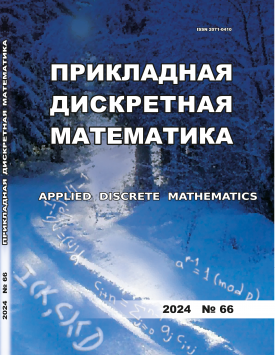In the paper, hereditary classes of L-structures are studied with language of the form L = Lfin ∪ L∞, where Lfin = ⟨R1,R2, . . . ,Rm,=⟩ and L∞ = ⟨Rm+1,Rm+2, . . .⟩, and also in L∞ the number of predicates of each arity is finite, all predicates are ordered in ascending of their arities and satisfy the non-element repetition property. A class of L-structures is called hereditary if it is closed under substructures. It is proved that the class of L-structures is hereditary if and only if it can be defined in terms of forbidden substructures. A class of L-structures is called universally axioma-tizable if there is a set Z of universal L-sentences such that the class consists of all structures satisfying Z. The problems of the universal axiomatizability of hereditary classes of L-structures are considered in the paper. It is shown that hereditary class of L-structures is universally axiomatizable if and only if it can be defined in terms of finite forbidden substructures. It is proved that the universal theory of any axiomatizable hereditary class of L-structures with a recursive set of minimal forbidden substructures is decidable.
Download file
Counter downloads: 8
- Title Axiomatizability and decidability of universal theories of hereditary classes of models of finite and infinite languages
- Headline Axiomatizability and decidability of universal theories of hereditary classes of models of finite and infinite languages
- Publesher
Tomsk State University
- Issue Prikladnaya Diskretnaya Matematika - Applied Discrete Mathematics 66
- Date:
- DOI 10.17223/20710410/66/2
Keywords
structure, hereditary class, universal theory, universal axiomatizability, decidabilityAuthors
References
Ильев А. В., Ильев В. П. Алгоритмы решения систем уравнений над различными классами конечных графов // Прикладная дискретная математика. 2021. №53. С. 89-102.
Никитин А. Ю., Рыбалов А. Н. О сложности проблемы разрешимости систем уравнений над конечными частичными порядками // Прикладная дискретная математика. 2018. №39. С. 94-98.
Балджанова Р. В., Илъев А. В., Илъев В. И. О сложности кластеризации графа в задаче с ограничениями на размеры кластеров // Прикладная дискретная математика. 2023. №60. С. 76-84.
Il'ev, A.V., Il'ev, V.P. Bounds for the clustering complexity in a graph clustering problem with clusters of bounded size //j. Math. Sci. 2023. V. 275. P.78-84.
Зыков А. А. Основы теории графов. M.: Вузовская книга, 2004. 664с.
Ершов Ю. Л., Лавров И. А., Тайманов А. Д., Тайцлин М.А. Элементарные теории // Успехи матем. наук. 1965. Т. 20. №4. С. 37-108.
Bozapalidis A. and Kalampakas A. An axiomatization of graphs // Acta Inform. 2004. V. 41. P.19-61.
Taylor W. Atomic compactness and graph theory // Fundamenta Mathematicae. 1969. V. LXV. P. 139-145.
Yamamoto M., Nishizaki S., Hagiya M., and Toda Y. Formalization of planar graphs // LNCS. 1995. V.971. P.369-384.
Caicedo X. Finitely axiomatizable quasivarieties of graphs // Algebra Univers. 1995. V. 34. No. 2. P.314-321.
Ильев А. В. Об аксиоматизируемости наследственных классов графов и матроидов // Сиб. электрон, матем. изв. 2016. Т. 13. С. 137-147.
Ham L. and Jackson М. Axiomatisabilitv and hardness for universal Horn classes of hypergraphs // Algebra Univers. 2018. V. 79. Art. 30.
Il'ev, A.V., Il'ev, V.P. On axiomatizability and decidability of universal theories of hereditary classes of matroids //j. Physics: Conf. Ser. 2019. V. 1210. Art. 012056.
Stronkowski M. M. Axiomatizations of universal classes through infinitarv logic // Algebra Univers. 2018. V. 79. Art. 26.
Ершов Ю.Л., Палютлт E. А. Математическая логика. M.: Наука, 1987. 336 с.
Горбунов В. А. Алгебраическая теория квазимногообразий. Новосибирск: Научная книга, 1999. 368+хiiс.
Ильев А. В. Разрешимости универсалвных теорий и аксиоматизируемости наследственных классов графов // Труды института математики и механики УрО РАН. 2016. Т. 22. №1. С. 100-111.

Axiomatizability and decidability of universal theories of hereditary classes of models of finite and infinite languages | Prikladnaya Diskretnaya Matematika - Applied Discrete Mathematics. 2024. № 66. DOI: 10.17223/20710410/66/2
Download full-text version
Counter downloads: 133